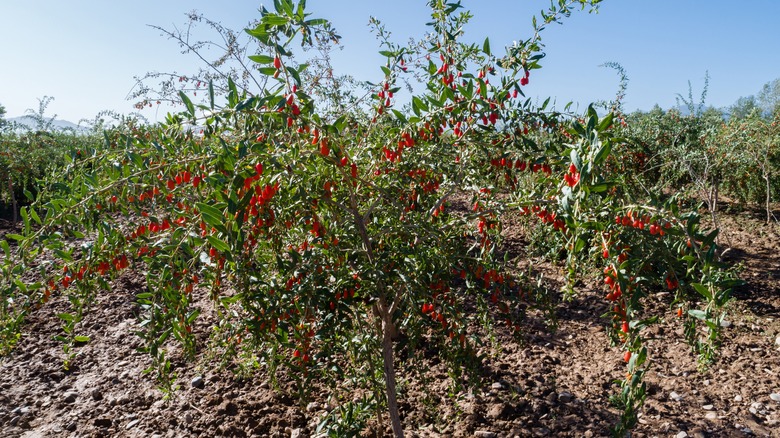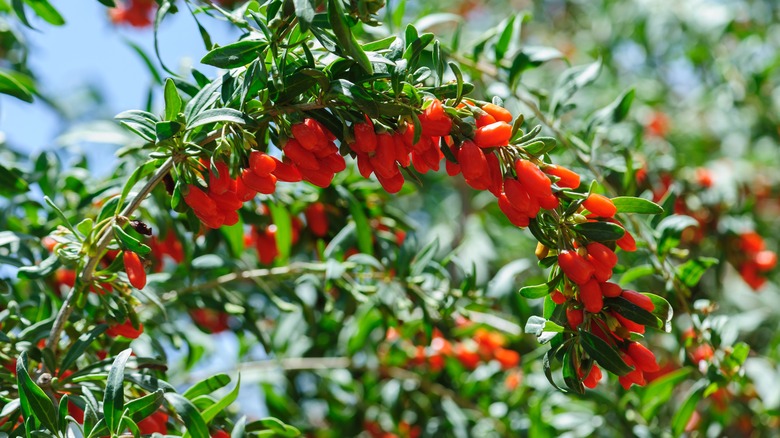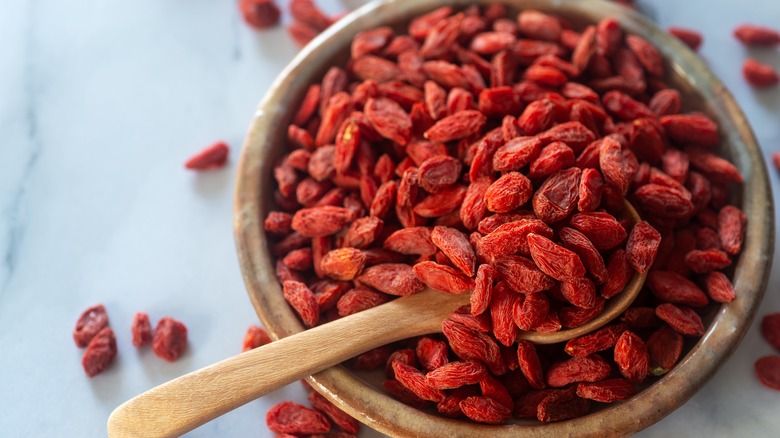What You Should Know Before Planting Goji Berry Seeds
Because goji berries contain powerful antioxidants, an abundance of vitamins and minerals, and other nutrients, they have been labeled a "superfood." Fortunately, there are many great ways to use them — dried or fresh, they're ideal for adding to a smoothie, making trail mix, or simply eating them raw. Whether you take the time to dry them first or not, the nutritional content is the same — the only thing that will be missing after drying goji berries is a bit of extra water. The only thing better than indulging in store-bought goji berries is indulging in those that you grew in your own garden. If you're looking for shrubs with edible parts you can grow in your yard, you might want to consider growing some of your own.
While a goji berry plant (Lycium barbarum) can be a great choice for growing in a garden, you need to prepare well before getting started. In particular, you should be aware that they're considered to be noxious weeds in certain parts of the United States, particularly in Montana and Wyoming. If grown in the right location, however, the effort can be well worth it. Goji berries are best grown in USDA zones 4 to 7 and prefer full sun and hot, dry conditions. If you meet these basic needs, and the plant isn't considered invasive in your area, you may want to get your hands on some goji berry seeds and see what you can do.
Providing the right conditions for your goji berry plants
In addition to choosing the right location for growing goji berries, there are other conditions that you'll need to meet as well. First of all, spend some time thinking about the soil. Remember that it's best to grow goji berries in slightly alkaline soil from 7.0 to 8.0 pH, and light loam is ideal. You should also be sure to space the plants correctly. Leave 4 to 5 feet in either direction to ensure they have enough room to grow properly. If you'd like to grow multiple rows of goji berries, leave about 2 to 4 feet between plants and about 6 to 8 feet between each row.
Especially right after first planting them, you'll want to provide sufficient water to encourage their growth until they're established. You'll generally want to add 1 inch of water weekly, but this varies depending on the soil. Fertilizer is an option too, but you shouldn't overdo it. In the U.S., a good rule of thumb is to add 4 to 5 tablespoons of 16-16-16 fertilizer for every 10 square feet annually. However, this should be reduced if the soil is particularly fertile. You'll also want to prune them annually to get the best results and to encourage new growth, although this won't usually be necessary during the first year.
Problems to avoid when growing goji berries
There are a few different obstacles that can prevent your goji berries from growing at their very best. You'll want to be sure to watch out for weeds — add mulch around the plants to keep them from being overrun by weeds and consider hand pulling weeds or pouring boiling water on them to kill them. As a last resort, you may want to use pre-emergent herbicide during the spring. You should also be aware that pests such as aphids, thrips, and gall mites can cause problems. Also, take steps to prevent powdery mildew from taking over your garden since fungal diseases such as these can get the better of the crop as well.
Once they're ready to pick, use proper harvesting techniques. Shaking the berries off of the plant isn't the best option since they won't come off as easily as other berries that are grown on bushes in the yard. It's best to simply pick goji berries by hand using a thumb and index finger. While it's not necessary to dry goji berries before eating them, doing so is the most popular way to indulge in this superfood. Fortunately, drying them is easy and can be done in several different ways. Simply setting them out in the sun works well if you live in a hot and dry place but you can also place them on a low setting in your oven or use a dehydrator to dry goji berries as well.


